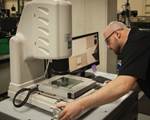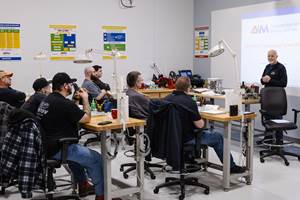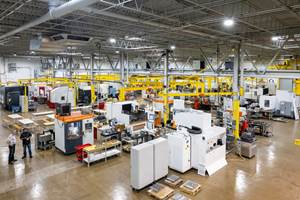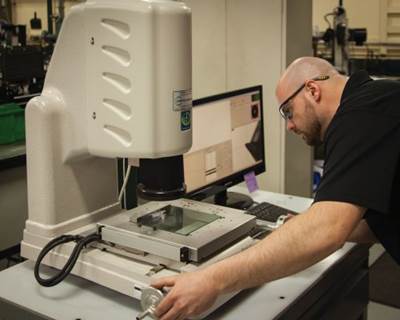Workforce development in manufacturing is no longer a buzzword; it’s a necessity. This became evident for Westminster Tool five years ago when we failed to fill a toolmaker opening. While our outreach efforts resulted in more than 100 applicants, only four people were qualified candidates, none of whom could satisfy the position due to their availability and location limitations. This lackluster response was the wake-up call that opened our eyes to the value of developing our talent internally.
This realization resulted in a paradigm shift for the company. We switched our hiring approach from filling positions to finding the right people to grow with our team. We needed to hire for character and provide efficient and effective training for skills. Our efforts focused on collaborating with outside support to develop educational programs at local community colleges, developing an internal training program (Westminster Academy) and establishing a business philosophy committed to growing people.
In just four years Westminster Tool has completely altered the way we do business. Our core focus shifted from being the best toolmakers to having the best team. We moved from being the smartest to the most curious, and we now identify challenges before they occur. Most importantly, we moved from having stagnant positions to being a dynamic team that is constantly learning and improving. We built strong connections within our community and school systems to ensure we get the best and brightest, and we created a strong internal training program to help them recognize and reach their greatest potential. While our average age has decreased by nearly 20 years, our throughput per person is at the highest it has ever been (by over 20 percent).
Although there were many challenges during our journey to becoming a training organization, the following three initiatives were critical in helping us address the skills gap.
1. On-Boarding Program
This new business philosophy varies greatly from typical manufacturers. We believe it is important to help new employees understand that our number one focus is the consistent growth and development of our people, not being the best at one job. We created a robust on-boarding experience to help new employees better acclimate to this culture. We also make it evident to new hires that the company has been eagerly preparing for their arrival by ensuring each employee has the tools he or she needs to be successful, such as an email address, network login, a key fob to access the building and some Westminster Tool swag.
We use the first few hours to review necessary human resources forms and provide a tour of the shop, their initial location, the lunch area, and bathrooms. It’s all about making the new hire feel welcome and comfortable. Each new hire moves through the same orientation process when joining our team, whether the company hired them as a vice president or production technician.
Another key component of Westminster’s on-boarding involves three hours of training on personal development, which includes emotional intelligence, personality profiles, learning styles, lean manufacturing, and DMAIC (Define, Measure, Analyze, Implement, Control).
Next, we jump into global and local orientation. Global orientation refers to the cultural aspects that all employees must become familiar with to achieve success at Westminster Tool. The Westminster Tool Direction is the key component of global orientation, which includes the company’s vision, core values, mission, culture, and key performance indicators (KPIs).
- Vision: Create a sustainable business environment which improves the quality of life for all who interact with Westminster, while growing employees by helping them to recognize and achieve their greatest potential.
- Mission: Westminster Tool is committed to providing a positive customer experience by engaging our customers in identifying their challenges. Westminster’s dedication to individual growth is the foundation of success that allows us to deliver manufacturing solutions that exceed customer expectations.
- Core Values: Dynamic, Motivated, Curious, Integrity
- KPIs: On Time, First Time, On Budget, Customer Service
This aspect of orientation helps ensure that each new hire can communicate the who, what and why of Westminster Tool because that is our organizational compass. For example, when employees decide between doing x or y, they must consider whether the choice aligns with the company’s vision and mission. Employees with this level of understanding become a team working toward the same vision of success. We have a written test that measures an employee’s level of proficiency on the Westminster Tool Direction two to three times a year. The current company-wide average on the test is 90 percent. We also use global orientation to review Westminster’s services, main customer base, internal systems, and improvement system. We spread global orientation over the first five mornings of employment to avoid overwhelming new employees. In the afternoons the new hire is working in his or her area, attending local orientation and acclimating to the company and culture. Local orientation is specific to the new hire’s position.
Another key component of Westminster’s on-boarding involves three hours of training on personal development, which includes emotional intelligence, personality profiles, learning styles, lean manufacturing, and DMAIC (Define, Measure, Analyze, Implement, Control). Emotional intelligence is the ability to maintain curiosity about another person which is critical to learning and improving the organization. It is impossible for someone to improve if they always think they know the answer. Personality profiles help employees to be curious about another’s point of view by understanding that different does not mean wrong. Learning styles ensure we provide training in the best format for the trainee to retain the information. Lean manufacturing ensures we are a continuous-learning organization that is constantly seeking ways in which to eliminate waste and flow value to the customer. DMAIC is a standard problem-solving process used to ensure that we have a universal tool and language for remaining data-driven versus opinion-driven.
While this may seem like a lot of information to cover in a short period, the approach continually evolves to make it easier for new employees to grasp concepts. For example, we now provide additional training at 30-, 60-, and 90-day intervals on orientation topics as well as refreshers through on-the-job training to ensure we maintain a pulse on a new employee’s performance and understanding. Those first 90 days are critical to succeeding at the company in the long term, so we take check-ins and feedback very seriously during this period. Most recently, we incorporated periodic testing to ensure that they are retaining and utilizing the information they learned during orientation. This testing provides a great opportunity for us to intervene and re-train before an employee forms inaccurate habits.
2. Personality Profiles
Emotional intelligence is the foundation of Westminster Tool, which demands that we provide employees with tools to help them become more self-aware and curious about another person’s point of view, embrace peoples’ differences and understand the value that each personality type contributes to the overall team. Emotional intelligence is critical to becoming a learning organization. If an employee assumes he or she knows everything, always has the answer or is always right, it is nearly impossible to help him or her learn and develop new skills. To be successful in rolling out this concept, we use an array of tools to help our employees minimize judgment.
One of the key tools we use is DISC, a behavior assessment tool based on a personality profile test comprising 28-word groupings. Participants identify the words in each group with which they resonate the most or least, ultimately providing a comprehensive profile based on four behavioral groups: dominant, influence, steadiness and compliant (see chart). The results not only identify primary and secondary personality traits but also help employees to better understand how they function in their natural state, at work, and how others perceive them. These results provide a detailed explanation of the strengths and weaknesses of each personality type and recommended approaches for working with different personality types. .
There is no right or wrong DISC style. Each one has positive attributes that are essential for an individual or team to be successful. Employees are better equipped to navigate conversations when they have the context of how and why people are different. Westminster provides annual DISC training, as a basic refresher course and to build upon current knowledge. DISC has helped Westminster employees understand their strengths and weaknesses, identify other styles in people, and adapt themselves to meet the needs of others. For example, when an employee is teaching someone a new concept, he or she sets his or her pace and style based on the needs of the “follower.” So, if a High D (dominant) trainer focuses on the big picture needs to teach a High C (compliant) person who is detailed-oriented, simply providing the High C with a high-level overview of the concept will not be successful. The High D must start with the details and work up to the big picture for the High C to receive and process the information effectively.
Even better is when you combine an employee’s learning style with his or her personality profile. Westminster uses this strategy to greatly reduce the time it takes to train someone effectively.
3. Learning Styles
Learning styles are tied very closely to personality profiles. A learning style is a manner in which a person is best able to learn and retain new concepts. Westminster Tool provides training on learning styles because it further improves communication and increases the speed of learning. The three styles are kinesthetic (learning by doing), visual (learning by seeing) and auditory (learning by hearing). Each person tends to have a dominant learning style for learning new concepts, but everyone is capable of learning through all three styles.
At Westminster, most of the employees are kinesthetic, which means they learn best with a hands-on approach and by completing tasks. This insight helped Westminster develop the most effective training for each employee. For example, insisting a kinesthetic employee sit through a presentation to learn a new concept is not going to yield the desired result quickly. However, when we develop training content for a group environment, we incorporate all three learning styles into the training.
Even better is when you combine an employee’s learning style with his or her personality profile. Westminster uses this strategy to greatly reduce the time it takes to train someone effectively. The trainer, not the trainee, is responsible for flexing their delivery to the mode that supports their trainee. Learning styles are also a valuable tool for improving interpersonal communication. When an employee understands the learning style of a co-worker, he or she can tailor their delivery to suit that person’s need. For example, speaking to someone who is a visual learner is not going to be as impactful as if you communicated via an email or a text.
Bringing it all Together
Integrating new employees as quickly as possible has been the key to success in addressing the skills gap at Westminster Tool. The proof is in the numbers. When we changed our hiring approach five years ago, the average employee age was 51, and we could not find qualified help. Today, the average employee age is 35, and the infrastructure exists to hire for character and train for skill, which includes proper on-boarding and using personality profiles and learning styles to refocus training and communication efforts.
Related Content
Mold Maintenance Continues to Matter: Enhanced Training Program in a New Facility
I attended a MoldTrax mold maintenance workshop in 2019 and shared my experiences, and despite changes in ownership, the workshop's remarkable value endures, as discussed in a recent Q&A with the current leadership.
Read MoreMaking Mentoring Work | MMT Chat Part 2
Three of the TK Mold and Engineering team in Romeo, Michigan join me for Part 2 of this MMT Chat on mentorship by sharing how the AMBA’s Meet a Mentor Program works, lessons learned (and applied) and the way your shop can join this effort.
Read MoreCross Training, In-House Capabilities and Collaborative Design Move Helm Tool Forward
Cross-training, bringing it all in-house, molding and collaborative design are essential to Helm Tool's success.
Read MoreHands-on Workshop Teaches Mold Maintenance Process
Intensive workshop teaches the process of mold maintenance to help put an end to the firefighting culture of many toolrooms.
Read MoreRead Next
2014 Leadtime Leader Awards Winner: Westminster Tool Inc.—Bridging the Gap without Losing Focus
A strong sense of self and a focus on people enabled this mold manufacturer to rapidly expand pre- and post-manufacturing services without getting overwhelmed by its own growth.
Read MoreReasons to Use Fiber Lasers for Mold Cleaning
Fiber lasers offer a simplicity, speed, control and portability, minimizing mold cleaning risks.
Read MoreHow to Use Continuing Education to Remain Competitive in Moldmaking
Continued training helps moldmakers make tooling decisions and properly use the latest cutting tool to efficiently machine high-quality molds.
Read More






















